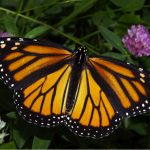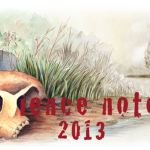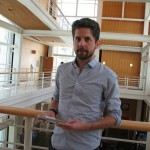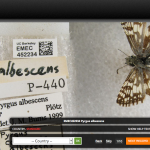
Patrick Daniel, of Squids4Kids, dissects a Humboldt squid at the 2012 Bay Area Science Festival. Photo by Ken Baltz
Marine biologist Bill Gilly wasn’t prepared for the greeting he received from St. Andrew’s Episcopal school in 2008. He’d come to the Saratoga, Calif. school to teach a special lesson on the Humboldt squid, complete with a dissection. Gilly approached the school and saw a line of ten-year-olds stretching out the door of his classroom. They jumped up and down, chanting.
“Squid! Squid! Squid!”
In the last five years, Gilly’s seen similar responses from hundreds of kids.
“I can’t tell you why people find squid cool, but I think most people do,” he said. “They’re mysterious and weird.”
He’s one of the leaders of Squids4Kids, a science education program that ships Humboldt squid from the cool waters of Monterey Bay to school dissection tables all over the country. Gilly and his colleagues hope to spark kids’ curiosity, scientific inquiry, and environmental awareness – with squid.
In 2005, fisheries biologist John Field had just started studying Humboldt squid at the National Marine Fisheries Service station in Santa Cruz. The squid (Dosidicus gigas) were then enigmatic newcomers to Monterey Bay. When Field saw his elementary-aged son’s enthusiasm for his research photos of squid, he arranged to bring a specimen into his son’s school.
Three years later, in 2008, Gilly traveled to Camp Ocean Pines in Cambria, Calif. for a two-day science class. He stretched squid out on picnic tables, and taught as he dissected. A science teacher in Massachusetts heard about Gilly’s hands-on lesson, and asked if he could get a frozen squid to use in his classroom. After shipping that first squid, Gilly realized the potential of an organized program, and launched Squids4Kids.
Today, any teacher can request a squid. In the 2011-2012 school year, the program shipped 40 squid. Field, in Santa Cruz and Gilly, at the Stanford-affiliated Hopkins Marine Station, jointly operate the program. Gilly’s lab takes requests for squid from teachers around the country. Field’s lab stores the squid in its freezers, shipping them out as needed. The teachers only pay $50 to cover shipping costs. Squids4Kids provides anatomical charts and squid dissection instructions to guide the teachers’ discussion.
The squid, usually pink or red, can reach up to 5 feet long and weigh up to 20 pounds. In a dissection, teachers cut open the bullet-shaped mantle and extracted the sharp, birdlike beak and the long, bony gladius, or pen – a remnant of the shell that long ago encased primitive squid. They also carefully extract the ink sac, located next to the liver. If they manage not to pop the sac, the dissection guide says, students will have plenty to ink to see if the squid’s “pen” lives up to its name.
“[The squid] never cease to amaze me,” Gilly said. “The more you learn about them, the more tricks they have to teach you.”
The squid come from research expeditions or from fishermans’ excess catch. Squids4Kids ships squid when they have them, but natural events, like El Niño, can disrupt the squids’ life cycle and Squids4Kids’ supply chain. For most of 2012, squid were out of stock.
They’re shipping again now, said Patrick Daniel, the Hopkins technician who coordinates the program. They’re now limited by the number of Styrofoam shipping boxes available, which are donated by local fish markets.
“If we had a nationally advertised program and a budget,” Gilly said, “we could probably send out as many squid as we could possibly do – 1,000 a year, maybe.”
Squids4Kids isn’t just about squid, Gilly said.
“Kids need nature. Squid is a weird aspect of nature they find fascinating. It’s a fun, cool animal they can be mystified by.” Many kids have never before, and may never again, see one of these animals, but the program aims to provide a close encounter with nature.
“Squid just happen to be the vehicle the Lord has provided us with,” Gilly said.
Even California students benefit from a little squid-ucation. One teacher in Modesto reported that most of her students didn’t know what a squid looked like prior to poking and prodding a Squids4Kids specimen. Modesto is only a two and a half hour drive from the squids’ home waters.
Field believes kids of any age are prepared to tackle scientific concepts. He returned to his son’s elementary school last fall to introduce the Young Scientist Club to the sights and pungent smells of squid.
“Any kind of hands-on exposure, whether to squid, physics, botany, or other kinds of science, is fantastic for the kids,” Field said.
Daniel’s favorite class to visit, he said, is at North Monterey County High in Castroville. He’s visited three years in a row now, improving his teaching and dissecting skills each time. He loves seeing a new group of curious students every year. The lessons run as a Q&A.
“There’s usually so many questions that the time goes by really fast,” he said.
By the time he packs up his squid and heads back to Pacific Grove, Daniel has inspired a new generation of kids with the humble awe of science, thanks to the awesome Humboldt squid.







Comments are closed.